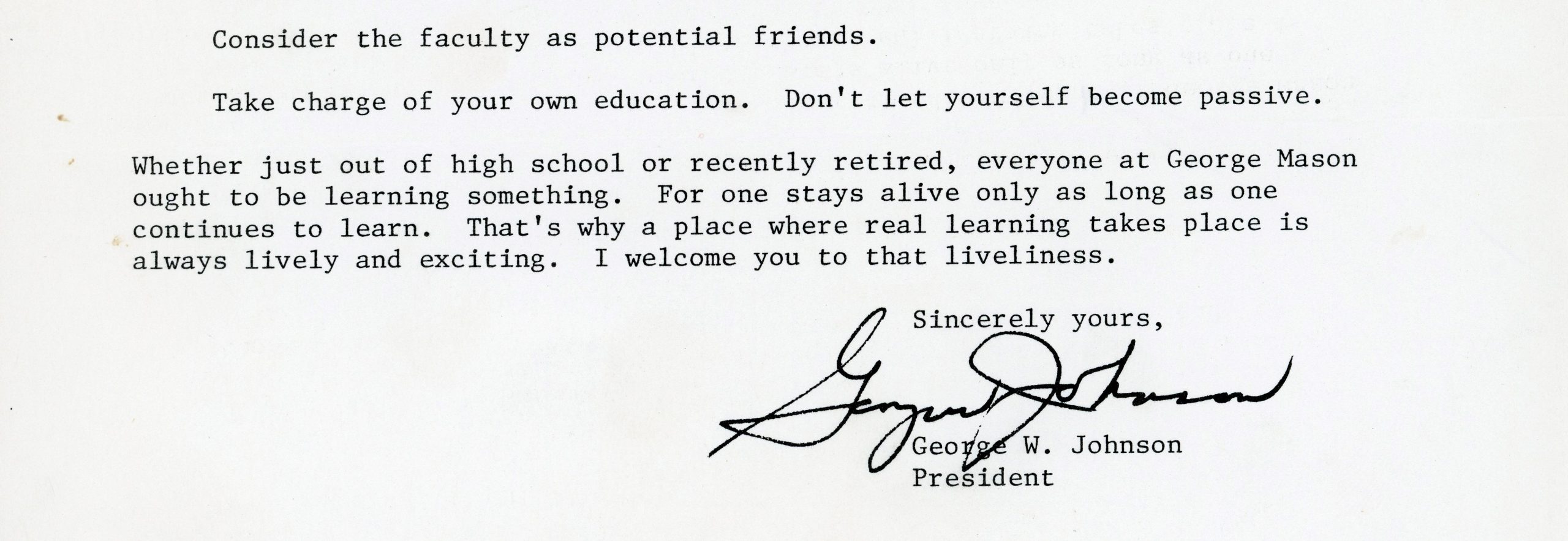
President George Johnson. Image found here.
This post was written by Lana Mason, Processing Student Assistant. Lana has an Associate of Arts degree in Fine Arts from Piedmont Virginia Community College. She is currently studying Art History at George Mason University. Lana was the recipient of the University Libraries Student Assistant Scholarship for the 2018-19 academic year.
This is the fourth post in a six-part blog series exploring the campus culture of George Mason University through the lens of each of its six past presidents’ tenures. The materials referenced in these posts are derived from the George Mason University Office of the President records.

“Welcome to George Mason University,” August 1978, George Mason University Office of the President records, R0019, series 6, 9.13, Special Collections Research Center, George Mason University Libraries.
Driven by President Krug’s readiness to retire, the administrators of George Mason University (GMU) searched diligently from 1977 through 1978 for someone to fill the presidency. They looked specifically for someone who had the capacity to help grow the university, and who was committed to remaining in the position for an extended period of time, unlike the shorter terms served by the previous three presidents. The man who ultimately caught their eye was George W. Johnson. Born in North Dakota, Johnson grew up and attended college there. During the Korean War, he served in the military. After leaving the service, he attended Columbia University where he received first his master’s degree, then his doctorate in English. He taught English for a period of time before entering into university administration at Temple University in Philadelphia, Pennsylvania. His journey to GMU was in a certain way unusual, as it was begun unexpectedly—his application for the position of president was originally submitted by a friend.[i] When the position was formally offered to Johnson, he chose to take it and moved to Virginia to begin his tenure at the young university. George W. Johnson is the longest-serving president in GMU’s history, and held the presidency during a very important time in the university’s life. Under Johnson’s leadership, Mason both experienced diversification and expansion of its academics and integrated itself meaningfully into the academic, economic, and communal facets of the Northern Virginia region.

“Center for Innovative Technology Proposed 1989-90 Operating Plan,” September 1987, George Mason University Office of the President records, R0019, series 6, 5.10, Special Collections Research Center, George Mason University Libraries.
During Johnson’s presidency, GMU continued along the rapid development trajectory it had begun in the early 1970s. Johnson’s administrative efforts emphasized creation and expansion of academic programs as well as the development of a variety of institutes. The university pursued expansion but also sought to promote certain programs and areas of expertise to enrich its still-developing institutional reputation. This included academic programs like the School of Conflict Analysis and Resolution, as well as broader efforts such as the push to make GMU a modern, technologically advanced university as part of a broader goal to promote the region as a technological hub.
Johnson’s approach to growing the university also prioritized developing relationships and, ultimately, partnerships with institutions and programs throughout the Northern Virginia community. These partnerships were not limited to academic connections, although GMU did develop relationships with local schools. Many such efforts were focused on connecting with institutions and groups working to promote cultural and economic development in the region. These connections, such as the one with the Center for Innovative Technology (CIT), were mutually beneficial and helped to strengthen not only GMU’s growth but that of the wider community. Because of this type of outreach and interconnection, GMU evolved into a prominent institution in Northern Virginia life.

“Cultural Diversity at George Mason University,” September 1993, George Mason University Office of the President records, R0019, series 6, 35.14, Special Collections Research Center, George Mason University Libraries.
Diversity became an important element of campus culture during Johnson’s tenure as president. Building off of the efforts of Dykstra’s administration to promote affirmative action within the school, the GMU community began to increasingly regard diversity as a strength. Administrative efforts to continue the trend of making the university a more welcoming and inclusive environments grew exponentially during Johnson’s administration. The conceptualization of diversity grew during that time from a specific focus on racial and ethnic diversity to one that was inclusive of gender, sexuality, cultural, and religious diversity. More information regarding gender and sexuality diversity and history at GMU during Johnson’s tenure can be found in the two-part blog series “Progress: LGBTQ Identities and Issues at George Mason University from the 1970s through the 1990s.” Johnson announced his impending retirement in 1995. He departed from the position at the end of the 1996 school year after nearly 20 years of service. He was succeeded by Alan G. Merten.
[i] http://ahistoryofmason.gmu.edu/exhibits/show/prominence/contents/georgewjohnson
Follow Special Collections Research Center on Social Media at our Facebook, Instagram, and Twitter accounts. To search the collections held at Special Collections Research Center, go to our website and browse the finding aids by subject or title. You may also e-mail us at speccoll@gmu.edu or call 703-993-2220 if you would like to schedule an appointment, request materials, or if you have questions. Appointments are not necessary to request and view collections.

